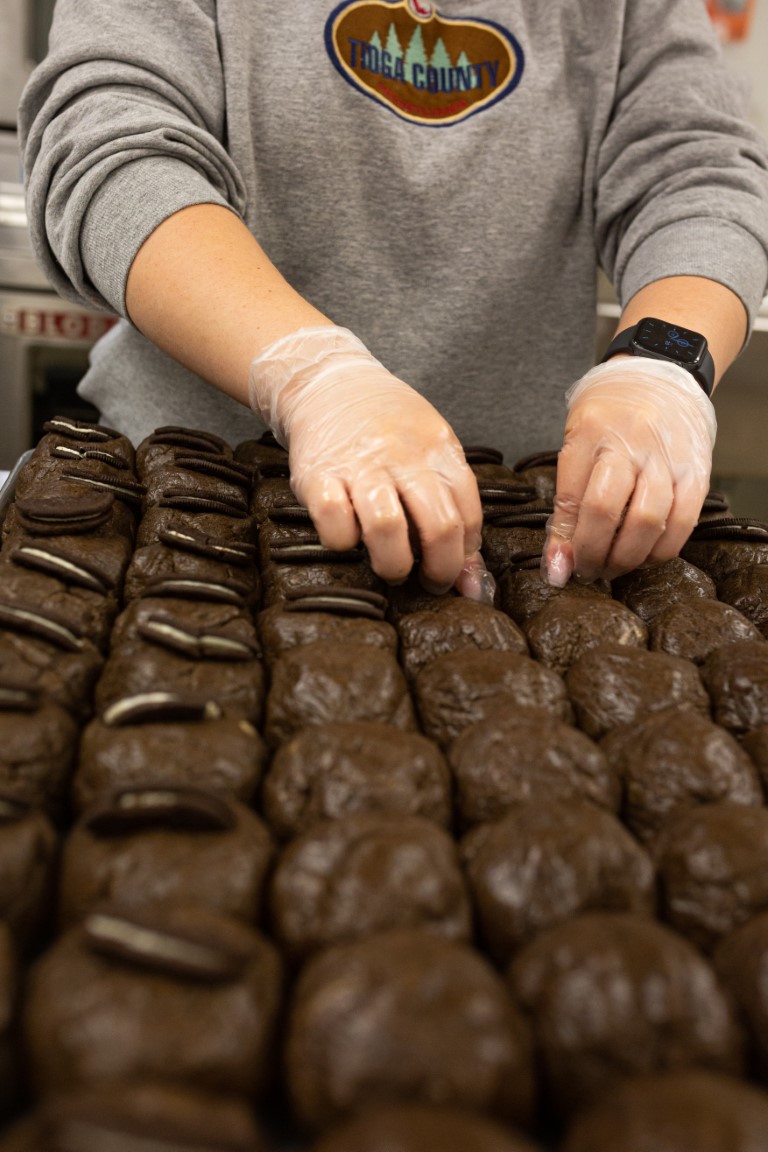When using a cookie scoop size chart, you guarantee consistent cookie sizes and even baking results. Cookie scoops come in various sizes, each identified by a number system where higher numbers indicate smaller scoops. For larger cookies, a #20 scoop holds roughly 3 tablespoons of dough. A medium #40 scoop carries about 1.5 tablespoons, ideal for standard cookies, while a #60 scoop handles 1 tablespoon for smaller treats. On the other hand, a #100 scoop is perfect for mini cookies with its 2-teaspoon capacity. Selecting the correct scoop size improves your baking precision and consistency, and understanding these details could further refine your baking skills.
Key Takeaways
- Cookie scoops ensure uniform cookie sizes for consistent baking results and professional appearance.
- Scoop sizes vary: #20 for larger, #40 for medium, #60 for smaller, and #100 for mini cookies.
- Use the appropriate scoop size for desired cookie diameter and adjust baking times accordingly.
- Spring-loaded, stainless steel scoops offer durability and ease of dough release.
- Cookie scoops are versatile, also useful for ice cream, cupcakes, and meatballs.
What Is a Cookie Scoop
A cookie scoop is a handy kitchen tool designed to portion out dough evenly, ensuring uniform cookies every time you bake. Understanding the cookie scoop numbering system is essential, as it helps you select the right size based on your desired cookie dimensions, while different types of cookie scoops, such as those with ergonomic handles or trigger mechanisms, can enhance your baking experience. By familiarizing yourself with these aspects, you can achieve consistent results and make the baking process more efficient and enjoyable.
Understanding the Cookie Scoop Numbering System
When diving into the domain of baking, you'll often encounter the cookie scoop, a handy tool that guarantees uniformity in your cookies. Understanding the cookie scoop numbering system is essential, as it helps you select the right size from the cookie scoop size chart. These scoops come in a variety of sizes, often referred to as disher scoop sizes, and are numbered to reflect their scoop size. The number corresponds to the approximate number of scoops that make up a quart. For instance:
- #20 scoop: Larger cookies, about 3 tablespoons.
- #40 scoop: Medium cookies, around 1.5 tablespoons.
- #60 scoop: Smaller cookies, roughly 1 tablespoon.
- #100 scoop: Mini cookies, approximately 2 teaspoons.
Different Types of Cookie Scoops
Though often overlooked, the cookie scoop is an essential tool for any baker aiming for consistency. A cookie scoop helps you create cookie dough balls of uniform size, leading to even baking and professional-looking treats. You'll find a variety of scoops available, each designed for specific tasks. The spring-loaded scoop is popular for its ease of use, allowing you to release dough easily. Stainless steel cookie scoops are durable and resist rust, making them a long-lasting choice. When selecting a scoop, consider the size of the cookies you wish to make. A smaller scoop is ideal for bite-sized treats, while larger scoops are perfect for substantial cookies. Remember, the right scoop guarantees your cookies bake evenly every time.

Choose Your Own Delightfully Perfect Cookies.
With almost 30 flavors to choose from, you can make your box as unique as you are.
Complete Cookie Scoop Size Guide
In this guide, you'll explore the various sizes of cookie scoops, including small, medium, and large, each with its specific uses in baking. Small scoops are perfect for bite-sized treats or uniform ingredient distribution, while medium ones are great for standard cookies, ensuring even baking. Large scoops cater to those who prefer bigger cookies or need consistent dough portions for larger batches, allowing you to choose the right size for your baking needs.
Small Cookie Scoop Sizes and Uses
Even if you're an experienced baker, choosing the right size for your cookie scoop can make a big difference in your baking results. A small cookie scoop, typically equivalent to about a tablespoon of dough, is perfect for creating medium-sized cookies. These scoops help you portion your dough into balls evenly, ensuring consistent baking times and uniform cookie sizes. They're essential baking tools for anyone who values precision and efficiency in the kitchen.
When using a small cookie scoop, consider these benefits:
- Uniformity: Every cookie will bake evenly, reducing the chances of overcooked edges.
- Time-saving: Scooping dough quickly minimizes prep time.
- Portion control: Ideal for those watching their serving sizes.
- Versatility: Use it for other recipes, like mini muffins or meatballs.
Medium Cookie Scoop Sizes and Uses
A medium cookie scoop is a versatile tool that can transform your baking experience. When you're baking cookies, using a medium scoop guarantees that each cookie is the same size, which leads to even baking and a professional look. This scoop typically holds about 1.5 tablespoons of cookie dough, making it perfect for producing medium-sized cookies. By using a medium scoop, you'll achieve consistent sizes and a uniform appearance, which helps in presentation and even cooking.
This tool simplifies the process of portioning cookie dough, saving you time during preparation. Furthermore, it minimizes mess and reduces the likelihood of overbaking or underbaking since each cookie will bake at the same rate. With a medium scoop, maintaining consistency in your baking becomes effortless and efficient.
Large Cookie Scoop Sizes and Uses
While medium cookie scoops offer consistency in medium-sized cookies, large cookie scoops take your baking to the higher standard by providing generous portions. Using large cookie scoop sizes guarantees that each ball of cookie dough is perfectly measured, leading to giant cookies that are both impressive and delicious. When you use level scoops, you create uniform cookies that bake evenly and look professional.
Here are some practical uses for large cookie scoops:
- Crafting giant cookies: Perfect for creating large, bakery-style treats that are sure to impress.
- Portioning dough for consistency: Guarantees each cookie is the same size, which helps in even baking.
- Scooping muffin batter: Ideal for filling muffin tins with precision, avoiding spills.
- Serving ice cream: Doubles as a great tool for scooping large portions of ice cream.
Cookie Scoop Size Chart and Measurements
Understanding the relationship between scoop size and cookie outcome is essential for achieving consistent results in your baking efforts. You'll need to convert scoop volume to diameter to guarantee your cookies bake evenly and meet your expectations, and familiarizing yourself with final cookie size guidelines will help you align with popular recipe requirements. By grasping these measurements, you can select the right scoop for your recipes and make sure your cookies turn out perfectly every time.
Volume to Diameter Conversion
When baking cookies, knowing how to convert scoop volume to cookie diameter can make all the difference in achieving that perfect batch. Understanding volume to diameter conversion helps you predict cookie sizes, ensuring consistent results. A tablespoon-sized scoop typically yields dough balls about 1 inch in diameter, but baking transforms them into larger cookies. This conversion is essential to avoid excess dough, which can lead to uneven baking.
Here are some helpful tips for converting volume to diameter:
- Use a chart to match scoop size to expected cookie diameter.
- Remember that different recipes might spread differently.
- For uniform cookies, weigh your dough balls.
- Adjust baking time based on cookie size.
Final Cookie Size Guidelines
A clear understanding of final cookie size guidelines can enhance your baking game. When you're following cookie recipes, knowing how many tablespoons of cookie dough to use for each scoop is vital. A standard cookie scoop usually holds about one to two tablespoons, impacting how many cookies per batch you can make. To keep your baking time consistent, it's important to use the same size scoop for every cookie. This uniformity prevents issues like one cookie being underbaked while another is overdone. Additionally, if you prefer flat cookies, adjusting the amount of dough or the baking temperature might help achieve that desired texture. By mastering these guidelines, you'll produce cookies that are consistently delicious and perfectly baked every time.
Popular Recipe Requirements
Many popular cookie recipes call for specific scoop sizes to guarantee perfect results every time. Using the right size scoop facilitates consistent shapes and even baking, perfect for creating picture-worthy treats. When you're preparing a batch of cookies, especially drop cookies, your favorite cookie scoop becomes your best friend.
- Small Size Scoop (#60): Ideal for mini cookies, yielding about 2 teaspoons of dough per scoop.
- Medium Size Scoop (#40): Perfect for standard-sized cookies, offering about 1.5 tablespoons of dough.
- Large Size Scoop (#20): Best for jumbo cookies, providing 3 tablespoons of dough.
- Extra-Large Size Scoop (#12): Great for oversized cookies, holding around 5 tablespoons of dough.
Using these scoops, you'll achieve perfect cookies every time, making sure your baked goods meet recipe requirements flawlessly.
How To Choose the Right Cookie Scoop
Choosing the right cookie scoop involves matching the scoop size to your recipe type, considering the consistency of your dough, and planning for your desired yield. If you're working with a thicker dough, you might need a larger scoop to properly form the cookies, while a smaller scoop could be more suitable for thinner, delicate batters. Additionally, thinking about the number of cookies you want to produce can guide your decision, ensuring you select a scoop that helps achieve the perfect batch size.
Matching Scoop Size to Recipe Type
When you're baking cookies, finding the right scoop size can make all the difference in achieving those perfectly uniform treats. Different cookie dough recipes call for different scoop sizes, especially when dealing with drop cookie recipes. A key factor is the range of sizes available; choosing the right scoop size guarantees each ball of dough bakes evenly. Consider how dough from scoop impacts the final cookie's texture and appearance.
Here are some tips to help you match scoop size to your recipe type:
- Small (2 teaspoons): Ideal for mini cookies or garnishes.
- Medium (1.5 tablespoons): Perfect for classic chocolate chip cookies.
- Large (3 tablespoons): Use for jumbo cookies or when the dough spreads less.
- Extra-large (4 tablespoons): Great for bakery-style cookies.
Selecting the correct size can enhance your baking game.
Dough Consistency Considerations
A critical aspect of selecting the right cookie scoop is understanding the consistency of your dough. Sticky dough might cling to a scoop, so you'll need one with a soft grip for easier handling. Consider the batter per cup, as thicker doughs often require larger scoops to guarantee uniformity. Dough temperature also plays a role; cold dough can be stiff and challenging to scoop, while warmer dough might be too soft. Don't forget the ambient temperature, as it can affect the dough's texture and behavior. A scoop that fits comfortably in your hand and allows for efficient portioning makes baking enjoyable and efficient. Keep these factors in mind to achieve perfect cookies every time, no matter the dough type.
Yield Planning Tips
Understanding dough consistency sets the stage for effective yield planning. Choosing the right cookie scoop is essential when you aim for perfectly uniform cookies. A cookie scoop size chart can guide you in selecting the appropriate scoop for your desired cookie size. Whether you're making bite-sized cookies or larger treats, consider these factors:
- Dough Thickness: Thick dough requires a larger scoop to maintain uniformity.
- Baking Time: Smaller cookies bake faster, so adjust your oven timer accordingly.
- Storage Needs: If you want to store cookies in an airtight container, confirm the scoop size matches your storage space.
- Kitchen Gadgets: Use consistent scoop sizes to utilize other kitchen gadgets, like baking sheets, efficiently.
Professional Baking Tips
Mastering the art of proper scoop handling can enhance your baking results, so guarantee you maintain a steady grip and consistent pressure for uniform cookies. While scoops are primarily for cookies, they're versatile tools that can portion batter for cupcakes, muffins, or even meatballs, expanding your culinary repertoire. To keep your scoops in top condition, regularly clean them, inspect for any damage, and store them in a dry place to prevent rust.
Proper Scoop Handling Techniques
When it comes to achieving consistent and professional-looking cookies, your scoop technique can make all the difference. Start by selecting the right cookie scoop size chart to guarantee uniformity. Use a scoop with a reliable spring mechanism and a stainless steel design for durability. These kitchen tools are essential in creating even portions every time. When scooping, press the flat scoop firmly into the dough for accurate sizing, then release smoothly using the spring mechanism. To enhance your technique, keep these tips in mind:
- Firm grip: Hold the handle securely to maintain control.
- Consistent pressure: Apply even force to get the same amount of dough.
- Release smoothly: Confirm the spring mechanism functions well.
- Clean regularly: Prevent dough buildup for consistent scooping.
Following these steps will help you perfect your cookie game.
Alternative Uses Beyond Cookies
A versatile cookie scoop isn't just for cookies; it has countless uses in the professional baking world. Referencing your cookie scoop size chart, these tools double as ice cream scoops, making perfect portions every time. For even cupcake batter distribution, a scoop guarantees consistent sizes, leading to uniform baking. When it comes to frosting on cupcakes, using a scoop can create an even base before you add decorative touches. Cake balls are another delightful treat where a scoop comes in handy, guaranteeing all pieces are the same size for even cooking and presentation. Whether you're portioning batter, frosting, or dough, knowing the right scoop size can enhance your baking game, guaranteeing precision and efficiency in every task.
Maintenance and Care Guidelines
Understanding the versatility of your cookie scoop is just the beginning—maintaining it properly guarantees its longevity and performance in the kitchen. Whether you're using cream scoops or giant scoops with colored handles, regular maintenance is key. After each use, submerge your scoop in hot water to prevent dough from sticking and guarantee easy cleaning.
Follow these maintenance tips:
- Rinse thoroughly: After scooping from a bowl of dough, rinse your scoop under running water to remove any residues.
- Dry completely: Prevent rust by drying your scoop thoroughly after washing.
- Check moving parts: Regularly inspect the mechanism, ensuring it's in good working order.
- Store safely: Keep scoops in a dry place, away from direct sunlight to preserve colored handles.
Our Journey to Cookie Perfection
At Taylor Chip, our expertise in cookie baking isn't just about following recipes – it's a passion that's been years in the making. Since 2015, we've been on a relentless quest to create the perfect cookie, experimenting with countless batches and refining our techniques. Our journey began as a fun date night activity and evolved into a shared obsession, leading us to master the art of cookie baking over several years.
Our dedication to perfecting cookies aligns perfectly with the precision required in using cookie scoops, as discussed in this article. We understand firsthand the importance of consistency in cookie size and shape, which is why we value tools like cookie scoops in our baking process. Our experience has taught us that the right scoop size can make all the difference in achieving that perfect, uniform batch of cookies every time.
By sharing our insights on cookie scoop sizes and their impact on baking, we're not just passing on information – we're offering you the benefit of our years of hands-on experience and passion for cookie perfection. Whether you're a novice baker or a seasoned pro, our expertise can help you elevate your cookie game and achieve professional-quality results in your own kitchen.
Frequently Asked Questions
How Do I Clean and Maintain My Cookie Scoop?
To clean your cookie scoop, wash it in warm soapy water, rinse thoroughly, and dry completely. For maintenance, periodically lubricate the moving parts with food-safe oil. Store it in a dry place to prevent rust.
Can Cookie Scoops Be Used for Non-Baking Purposes?
Yes, you can use cookie scoops for non-baking tasks. They're great for portioning meatballs, fruit, or ice cream. Just make certain you clean them thoroughly after each use to maintain their functionality and longevity.
Are Cookie Scoops Dishwasher Safe?
You're wondering if cookie scoops are dishwasher safe. Most are, but always check the manufacturer's instructions first. Some materials might degrade over time. Keeping them clean guarantees they last longer, so hand wash if in doubt.
What Materials Are Cookie Scoops Typically Made From?
Cookie scoops are typically made from stainless steel, offering durability and ease of cleaning. You'll also find some with plastic handles for comfort. Always check your specific scoop's material to ascertain it's dishwasher safe and long-lasting.
How Do I Fix a Cookie Scoop That Isn't Releasing Dough Properly?
First, check if any dough is stuck in the mechanism. Clean it thoroughly. If it's still not releasing, apply a small amount of food-safe lubricant to the moving parts. Test it to guarantee smooth operation.
Conclusion
To sum up, understanding cookie scoop sizes is vital for attaining consistent results in baking. By using the right scoop, you guarantee uniformity in cookie size and even cooking, which improves both the texture and presentation of your baked goods. Refer to the size chart to match your desired cookie dimensions with the appropriate scoop. With this knowledge, you'll confidently select the right tools and enhance your baking skills, producing professional-quality cookies every time.











